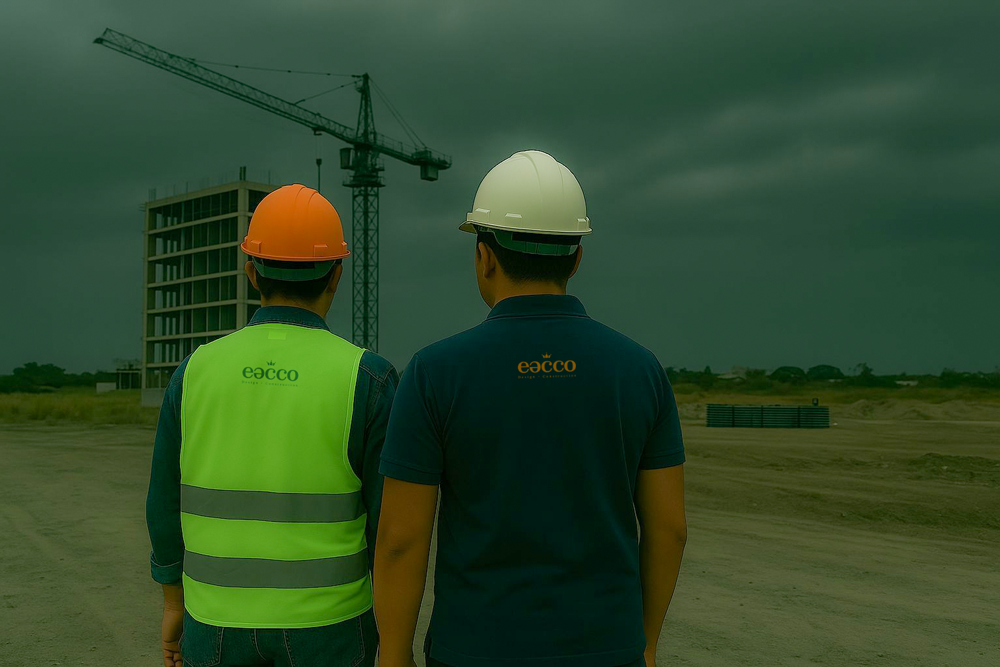
Construction is a process where the building phase and timeline invariably encounter risks and challenges during the rainy season, with the impact varying by project scale. In the Philippines, an article from PhilStar noted that not only do construction projects suffer during the monsoon season, but there is also a direct link to employment that declines as the rains approach (read their full article here). This shows how even tiny water droplets play a major role in laying the foundations of our spaces and compels you to ask your architects during consultation: “Which season is best for construction?”
This is a highly plausible question that also raises several underlying factors for experts in design and construction to consider. Although weather remains unpredictable and can derail any construction project leading to material erosion, worker safety issues, and timeline delays that may incur liquidated damages, experts must examine at least three key aspects before answering.
Questions from Experts for Rainy Season Construction
What Type of Project Do You Want to Build?
At Eacco Construction Corporation, we specialize in crafting premium spaces from residential projects like houses and condominiums to commercial office spaces, and retail establishments such as restaurants and coffee shops. Whether it’s ground-up construction, as-built planning, renovations, or interior fit-outs, understanding the project type is vital.
For example, projects built from the ground up (e.g., restaurants, coffee shops, residential houses) are generally less ideal to start during the rainy season. Continuous rainfall can cause soil erosion, damage construction materials, increase worker hazards like slips and falls, and overwhelm drainage systems. In contrast, fit-out projects such as office space renovations, condominium updates, or even some coffee shop remodels that often take place indoors and can be more feasibly executed during the rainy season.
What Are the Design Considerations and Inspirations?
Every client desires a space that is uniquely customized to their taste in art, color, furniture, and overall ambiance. Though these design aspects may seem secondary initially, they significantly impact the construction process, particularly through the supply chain. For instance, if a client chooses to import furniture and building materials due to sentimental ties or specific design inspirations, the timing of deliveries becomes crucial. During the monsoon season, typhoons, heavy rains, and strong winds can delay shipments and damage goods. Logistics teams must implement rigorous safety protocols to prevent mishaps, ensuring that employees and materials are not exposed to the risks of inclement weather. This chain reaction emphasizes that even localized projects face delays when the supply chain is disrupted by seasonal challenges.
What Documents and Permits Do You Have?
A sometimes-overlooked factor is the paperwork. In the Philippines, construction projects require numerous permits at every stage, building permits, zoning clearances, environmental compliance documents, barangay clearances, and occupancy permits. During the rainy season, these processes can be significantly delayed due to hazardous road conditions, traffic congestion, and the overall slowdown of administrative operations.
Imagine beginning your dream home construction with locally sourced materials, only to face persistent delays because essential permits have not been processed in time. Such delays not only push back your timeline but also increase the risk of material degradation from prolonged exposure to moisture, escalating costs for damage control.
Key Takeaways
Construction during the rainy season is challenging but not impossible. Decades of innovation have provided strategies to mitigate rain-related delays; however, planning remains essential. The monsoon season is best used as the time to consult with your architects, builders, and contractors about scheduling your project for the dry season ensuring that risk and reward are closely aligned with every decision.
Make the most of the rainy season by collaborating with experts to gather design inspirations, secure material procurements, and finalize necessary permits. This proactive approach allows you and your architectural team to synchronize timelines and execute the project smoothly during the more reliable dry season. For further insights and community support, visit our community on Facebook or Reddit at AskBuildersPh. Share your questions, insights, and experiences as you discuss design and construction challenges nationwide.
Leave a Reply